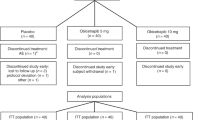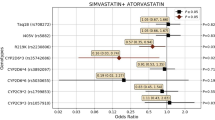Abstract
The cardiovascular benefits of therapy with the 3-hydroxy-3-methylglutaryl coenzyme A reductase inhibitors (statins) are well documented. Undertreatment of dyslipidemia remains pervasive, however, and the introduction of more-aggressive optional LDL-cholesterol targets in US guidelines only heightens the challenges of reaching the target values. Combination therapy with a statin and the cholesterol absorption inhibitor ezetimibe could help in the management of patients who have an inadequate reduction in cholesterol after making changes to lifestyle or taking statins alone. The effects of the combination on cardiovascular risk remain speculative, however, and clinical trials are in development. In this Review we consider the rationale for combination therapy in the context of achieving LDL-cholesterol goals.
Key Points
-
The cardiovascular-risk-reducing effects of statins compared with placebo have been demonstrated in several trials. Ezetimibe, a member of the class of cholesterol absorption inhibitors, can reduce LDL-cholesterol level when used as monotherapy and can accentuate LDL-cholesterol reduction when combined with statins.
-
Optional lower targets for LDL cholesterol proposed by recent guidelines will require intensified treatment, which could necessitate greater use of combination therapies such as statins plus ezetimibe.
-
Preliminary data from a single-pill preparation of simvastatin plus ezetimibe indicate greater achievement of treatment goals for LDL cholesterol compared with statin monotherapy.
-
Trials are in progress to evaluate the effect of this combination on clinical and other endpoints.
This is a preview of subscription content, access via your institution
Access options
Subscribe to this journal
Receive 12 print issues and online access
$209.00 per year
only $17.42 per issue
Buy this article
- Purchase on Springer Link
- Instant access to full article PDF
Prices may be subject to local taxes which are calculated during checkout




Similar content being viewed by others
References
Cohen JC et al. (2006) Sequence variations in PCSK9, low LDL, and protection against coronary heart disease. N Engl J Med 354: 1264–1272
Vaughan CJ and Gotto AM Jr (2004) Update on statins: 2003. Circulation 110: 886–892
Grundy SM et al. (2004) Implications of recent clinical trials for the National Cholesterol Education Program Adult Treatment Panel III guidelines. Circulation 110: 227–239
Goff DC et al. (2002) Primary prevention of high blood cholesterol concentrations in the United States. Arch Intern Med 162: 913–919
Ford ES et al. (2003) Serum total cholesterol concentrations and awareness, treatment, and control of hypercholesterolemia among US adults: findings from the National Health and Nutrition Examination Survey, 1999 to 2000. Circulation 107: 2185–2189
Arnett DK et al. (2005) Twenty-year trends in serum cholesterol, hypercholesterolemia, and cholesterol medication use: the Minnesota Heart Survey, 1980–1982 to 2000–2002. Circulation 112: 3884–3891
Pearson TA et al. (2000) The lipid treatment assessment project (L-TAP): a multicenter survey to evaluate the percentages of dyslipidemic patients receiving lipid-lowering therapy and achieving low-density lipoprotein cholesterol goals. Arch Intern Med 160: 459–467
Davidson MH et al. (2005) Results of the National Cholesterol Education (NCEP) Program Evaluation ProjecT Utilizing Novel E-Technology (NEPTUNE) II survey and implications for treatment under the recent NCEP Writing Group recommendations. Am J Cardiol 96: 556–563
Baigent C et al. (2005) Efficacy and safety of cholesterol-lowering treatment: prospective meta-analysis of data from 90,056 participants in 14 randomised trials of statins. Lancet 366: 1267–1278
Kita T et al. (1980) Feedback regulation of 3-hydroxy-3-methylglutaryl coenzyme A reductase in livers of mice treated with mevinolin, a competitive inhibitor of the reductase. J Clin Invest 66: 1094–1100
Burnett JR et al. (1999) The magnitude of decrease in hepatic very low density lipoprotein apolipoprotein B secretion is determined by the extent of 3-hydroxy-3-methylglutaryl coenzyme A reductase inhibition in miniature pigs. Endocrinology 140: 5293–5302
Cannon CP et al. (2004) Intensive versus moderate lipid lowering with statins after acute coronary syndromes. N Engl J Med 350: 1495–1504
Davidson MH (2005) Reducing residual risk for patients on statin therapy: the potential role of combination therapy. Am J Cardiol 96: 3K–13K
Ballantyne CM (2005) Rationale for targeting multiple lipid pathways for optimal cardiovascular risk reduction. Am J Cardiol 96: 14K–19K
Roberts WC (1997) The rule of 5 and the rule of 7 in lipid-lowering by statin drugs. Am J Cardiol 80: 106–107
Insull W Jr (2006) Clinical utility of bile acid sequestrants in the treatment of dyslipidemia: a scientific review. South Med J 99: 257–273
Levy DR and Pearson TA (2005) Combination niacin and statin therapy in primary and secondary prevention of cardiovascular disease. Clin Cardiol 28: 317–320
Jones PH and Davidson MH (2005) Reporting rate of rhabdomyolysis with fenofibrate + statin versus gemfibrozil + any statin. Am J Cardiol 95: 120–122
Patel SB (2004) Ezetimibe: a novel cholesterol-lowering agent that highlights novel physiologic pathways. Curr Cardiol Rep 6: 439–442
Gupta EK and Ito MK (2002) Ezetimibe: the first in a novel class of selective cholesterol-absorption inhibitors. Heart Dis 4: 399–409
Sudhop T et al. (2005) Sterol transporters: targets of natural sterols and new lipid lowering drugs. Pharmacol Ther 105: 333–341
Davies JP et al. (2005) Inactivation of NPC1L1 causes multiple lipid transport defects and protects against diet-induced hypercholesterolemia. J Biol Chem 280: 12710–12720
Bosner MS et al. (1999) Percent cholesterol absorption in normal women and men quantified with dual stable isotopic tracers and negative ion mass spectrometry. J Lipid Res 40: 302–308
Dujovne CA et al. (2002) Efficacy and safety of a potent new selective cholesterol absorption inhibitor, ezetimibe, in patients with primary hypercholesterolemia. Am J Cardiol 90: 1092–1097
Salen G et al. (2004) Ezetimibe effectively reduces plasma plant sterols in patients with sitosterolemia. Circulation 109: 966–971
Jakulj L et al. (2005) Inhibition of cholesterol absorption by the combination of dietary plant sterols and ezetimibe: effects on plasma lipid levels. J Lipid Res 46: 2692–2698
Pearson TA et al. (2005) A community-based, randomized trial of ezetimibe added to statin therapy to attain NCEP ATP III goals for LDL cholesterol in hypercholesterolemic patients: the ezetimibe add-on to statin for effectiveness (EASE) trial. Mayo Clin Proc 80: 587–595
Ballantyne CM et al. (2005) Dose-comparison study of the combination of ezetimibe and simvastatin (Vytorin) versus atorvastatin in patients with hypercholesterolemia: the Vytorin Versus Atorvastatin (VYVA) study. Am Heart J 149: 464–473
New Clinical Trial for VYTORIN™ (ezetimibe/simvastatin) Merck/Schering-Plough (online 9 December 2004) [http://www.medicalnewstoday.com/medicalnews.php?newsid=17578] (accessed March 30, 2006.)
Kastelein JJ et al. (2005) Comparison of ezetimibe plus simvastatin versus simvastatin monotherapy on atherosclerosis progression in familial hypercholesterolemia. Design and rationale of the Ezetimibe and Simvastatin in Hypercholesterolemia Enhances Atherosclerosis Regression (ENHANCE) trial. Am Heart J 149: 234–239
Davies GM et al. (2005) Projected coronary heart disease risk benefit with ezetimibe. Atherosclerosis 179: 375–378
Anderson KM et al. (1991) An updated coronary risk profile, a statement for health professionals. Circulation 83: 356–362
Sager PT et al. (2005) Effects of ezetimibe coadministered with simvastatin on C-reactive protein in a large cohort of hypercholesterolemic patients. Atherosclerosis 179: 361–367
Denke MA (2004) Coadministration of multidrug therapy to achieve lipid goals. J Am Osteopath Assoc 104: 17–22
Acknowledgements
The authors wish to acknowledge the assistance of J Jou, in the editorial preparation of this manuscript.
Author information
Authors and Affiliations
Corresponding author
Ethics declarations
Competing interests
Dr Gotto discloses that he has served as a consultant for Merck-Schering Plough, the company that markets ezetimibe and ezetimibe/simvastatin. He also has served as a consultant for the following companies with interests in lipid-lowering medications: AstraZeneca Pharmaceuticals, Bristol Myers-Squibb, Co., Johnson & Johnson Merck, Kos Pharmaceuticals, Kowa, Merck & Co, Inc., Novartis, Pfizer, Inc., and Reliant Pharmaceuticals.
JA Farmer declared he has no competing interests.
Rights and permissions
About this article
Cite this article
Gotto, A., Farmer, J. Drug Insight: the role of statins in combination with ezetimibe to lower LDL cholesterol. Nat Rev Cardiol 3, 664–672 (2006). https://doi.org/10.1038/ncpcardio0711
Received:
Accepted:
Issue Date:
DOI: https://doi.org/10.1038/ncpcardio0711
This article is cited by
-
Effect of Extended-Release Niacin or Ezetimibe on Carotid Intimal Thickness: The ARBITER-HALTS Study
Current Atherosclerosis Reports (2010)



